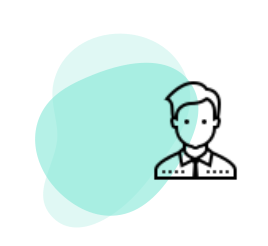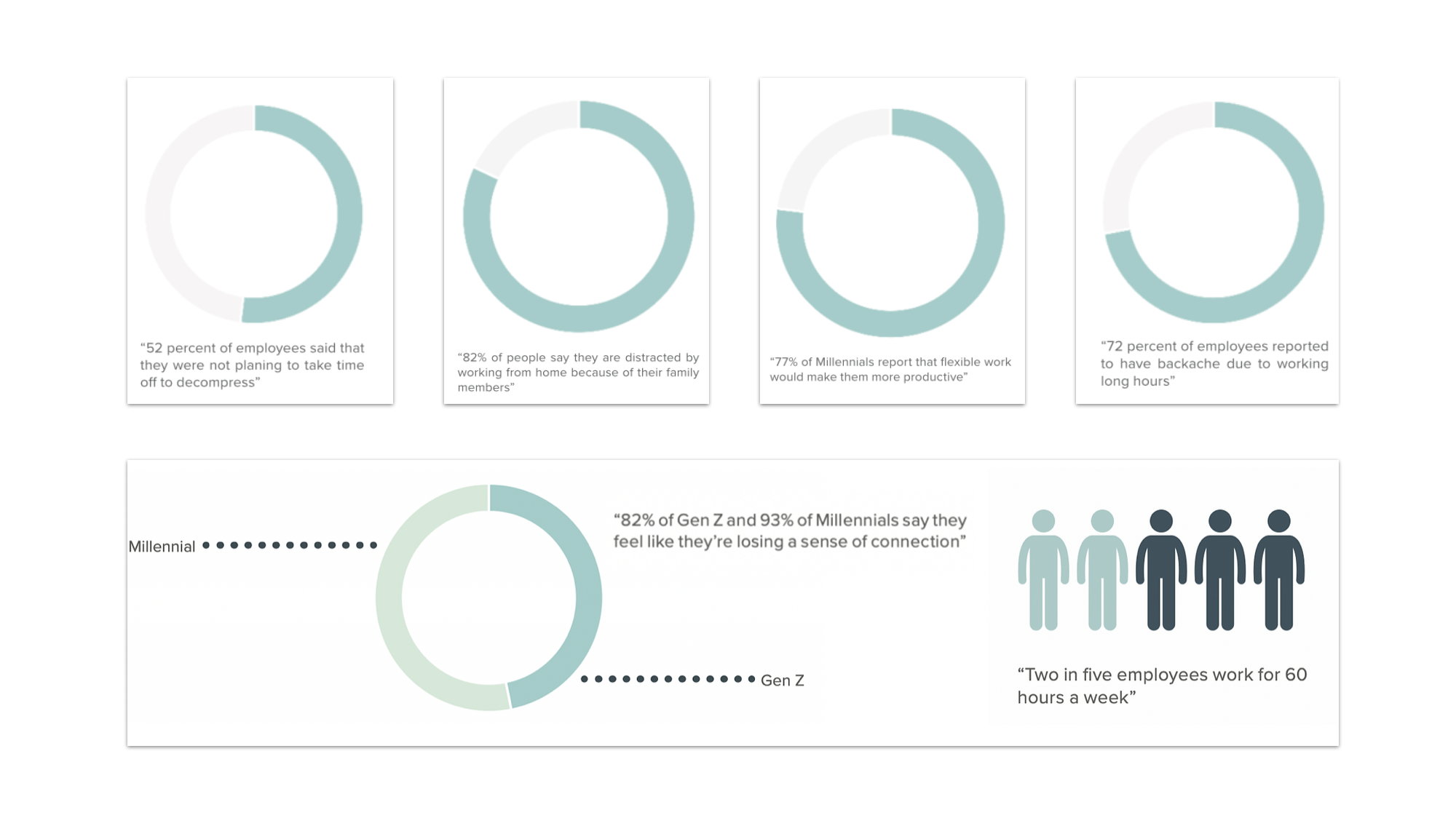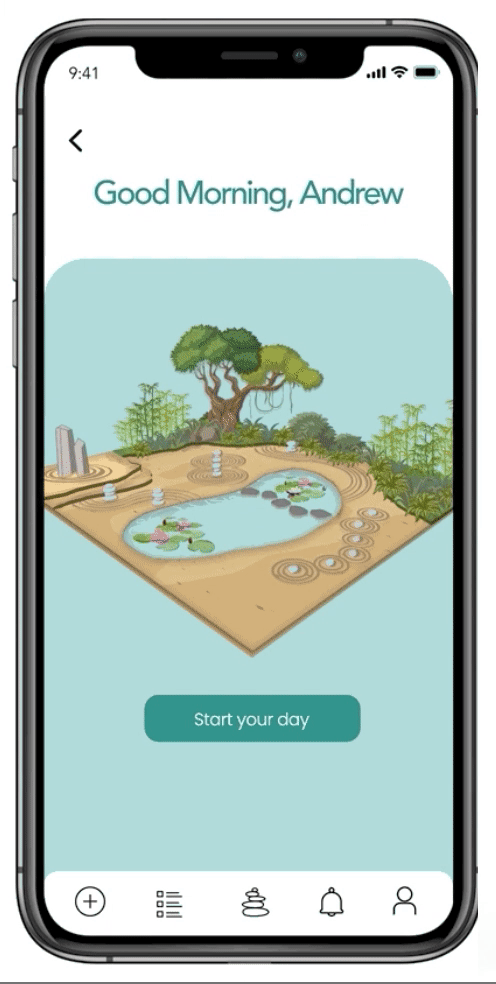

Pebble
UX Research | Product development | B2B
Pebble is a tool that will assist you foster mini-breaks into your busy "work from home" schedule and prevent burnout

Overview
COVID -19 has made everyone work from home and this has become the "new normal". However, people have been facing a problems in maintaining a work-life balance which has led to extensive work hours and even burnout. Focusing on this as the primary problem we have designed Pebble. The Pebble app reminds users to take mini-breaks throughout the day. As a result, leading to increased productivity and a happier community achieving work-life balance.
Project timeline
10 Weeks
Team
Multidisciplinary team of 11 students
Role
UX Research
UX Design
Tools
Figma
Photoshop
Keynote
Miro
Indesign
Design process
We used double diamond framework for our design process

How might we design and deliver an inclusive supportive experience, enabling employees to be productive, engaged, and successful, while working from home in this new era?
Secondary research
Primary research
Instead of recreating the workplace at home, Let’s make work a place that feels like home.
At the beginning of our SCADpro, we discussed the challenges we were facing. Employers & employees were in the stage of transitioning to working from home, possibly permanently. We faced the challenge accommodating and caring for the new "remote" employee.
What participants said during the interviews, all the problems led to one problem “BURNOUT”
This is how we felt
A sneak peak to what BURNOUT looks like
Data analysis
Key Insights and takeaways from research
Employers are willing to promote and incentivize employees to maintain high productivity
Human Resources at medium to large companies were open to various approaches, previously unthought-of, including reducing work hours, promoting breaks, and scheduling company-wide disconnect days as a way to maintain productivity.
People have become inactive working from home
People forget or don't prioritize taking breaks like drinking water, exercising and stretching as work from home can be done sitting at one place
People spend more hours working while working from home
This boosts productivity to an extent but can lead to burnout and family challenges due to lack of work - life balance. No separation between work and living space is a key root cause.
Strategies
By using 5 E’s framework it helped us building holistic and meaningful experiences, Later we used Eisenhower matrix to find out major wins and high efforts in our services.
The big takeaway was build around “BREAK-MATTERS” and how we should incorporate & incentivize seamless break taking idea into the everyday schedule of remote employees.
Solution
Introducing “PEBBLE”
Pebble eases the burnout of remote employees who wants to live a quality and healthy life. Our scheduling platform integrates with the users’ calendar and assists them to take productive and recreational breaks from their monotonous work life from home.
Design criteria
Cluster breaks into two groups : Mini & big breaks. To Encourage remote employees/ users to step away from their screen time & pursue their desired hobbies.
To provide gamification service. Remote employees would want to decompress their time and turn on their zen mode. The Intrinsic and extrinsic rewards are for their encouragement and motivation.
To develop a social community among the remote employees where they can share their breaks and decompress their time
Competitive analysis
Be Focused uses the Pomodoro technique to boost productivity of the users with their desired intervals
Headspace is a wellness app that assists users to deal with their mental health by the help of meditation.
Habitica is a productivity app that uses gamification to help the player keep track of and remain motivated to achieve their goals. In order to “win” you have to be active and constantly plugging in your daily tasks.
Social feed of physical activities to see their friends' & loved ones progress and activities they are involved in.
Why Pebble?
Pebble’s main goal is to promote and enhance a healthier lifestyle, but it doesn’t limit its opportunities only to few activities. The users have a chance to schedule any activities they enjoy doing for those break times.
Pebble uses IOT system for scheduling the pebble breaks, this assists the user not to be constantly engaged with the devices. Assisting them avoiding their daily distractions
Pebble does not limit its use only by a system technique. It is customizable for any user, in order to set up based on what works for the user and it does all of that while introducing gamification platform. Where users can see their progress on their daily interactive breaks.
Information Architecture
We created Information architecture, which assisted us in creating a backbone of this application
Wireframes and Iterations based on A/B testing
To add all Icons and notifications for users to check their status
To include more physical and home activities for users to take part in
An option to customize their timings and to sync with their personal calendars
Users said that endless scrolls can be addictive & our goal was to decrease addiction to use of technology rather than increase it.
Users preferred this screen over the previous one because they can visually look at the garden progress and profile. This motivates them to work on themselves
The visual aesthetics factors was missing according to the users and they couldn’t check their status
Users preferred this screen over the previous one because they can look at their progress which reminds them to take break also they can see their rewards
Users didn’t resonate with this as each breaks were segregated. User’s didn't prefer this journey
Users preferred this as it’s keeping all the breaks together and thus making it a longer scroll option on one a single page
In the rewards screen section users wanted to see their reward points in one screen and would like to see redeem options
Users preferred this screen as this page has required content for their reward points journey
Branding page
User Journey map - Before the service
Final prototype

SYNC
Once you’ve downloaded the app and you are all signed up, you have the option to sync a calendar of your choice. Once your calendar is synced, Pebble will craft breaks into your schedule. If you don’t want to sync to your calendar, you always have the option to customise your own break schedule
Setup
Once the user is logged in, they start their day by choosing by choosing their activity for boulder (longer) breaks and pebble (shorter) breaks. Users can select boulder breaks to occur or pebble will seamlessly schedule them for you with the help of smart sync Calendars.
After your breaks are setup, you’ll start your day. Users will receive 2 notifications in groups related to boulder and mini breaks. Boulder breaks are scheduled and Pebble breaks are customized by the app with the help of IOT.
Gamification
Introducing Gamified elements to help trigger a sense of acquirement, and achievement is everything for productivity. Everytime the user finishes an activity, they get a notification asking them whether they’ve have completed the activity. Once they click on the action bottom saying they completed the activity, and when done they get pebbles as incentives.
As your pebbles stack higher, so does the motivation to take breaks. By slowly increasing the amount of pebbles it takes to make upgrades, Users can slowly and steadily build their garden over time. Once they earn the required number of pebbles, these can be redeemed to update their garden automatically.
Bringing a piece of yourself into Pebble is what’s going to make the experience more enjoyable and gratifying. This is why the setting can be customized. In addition to the zen garden, pebble offers other options for the user to be the one who decides where he wants to see the result of his breaks.
Community Feed
Photo-feed: You have the option to share a photo of you completing your break to your friends/family/colleagues.
Garden Share feature: This lets you see your friend's garden. By seeing your friends’ gardens and how much progress they have made, this creates a healthy form of competition.
Community breaks : Here, you can have a shared garden with a co-worker or friend or family member. Once the activity is completed both you and your friend receive double rewards. This incentivizes you to interact with your community and take mutual breaks.
You will be able to challenge your coworkers/ friends to support them in taking more breaks so that they start building their habit of taking breaks frequently.
Rewards and Motivations
Pebble uses a mix of extrinsic and intrinsic motivators. Our extrinsic motivator is the reward of pebbles that will eventually be redeemed for real rewards, such as a gift card to Starbucks or Uber eats. This is used a lot for one time simple tasks, like the boulder break.
Our intrinsic motivator is the habit of doing the activity itself, as we are more likely to do something that we are interested in like reading a book, exercising, meditating, etc. Using these hand-in-hand increases motivation and gives an incentive to want to complete the task at hand.
User Journey map - After the service
My learnings and takeaways
Breaks has been shown to be important in recovering from stress , which can, in turn, improve your performance. I strive to incorporate them into my project.
As a lead UX researcher it was important to listen to what my peers has to say and considering all factors.
Not to be stuck in one direction, consider other ideas and keep on iterating.




























































